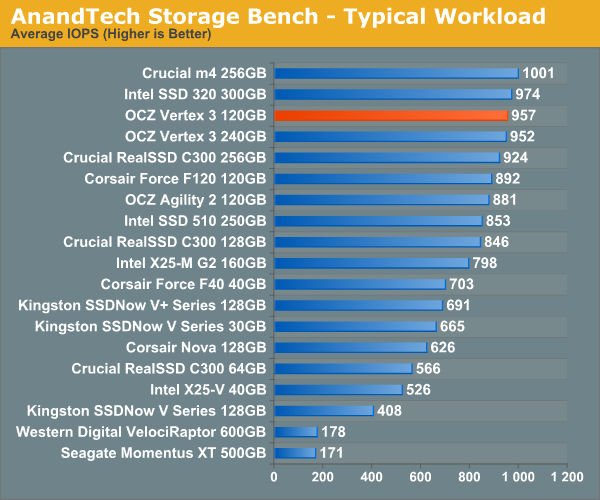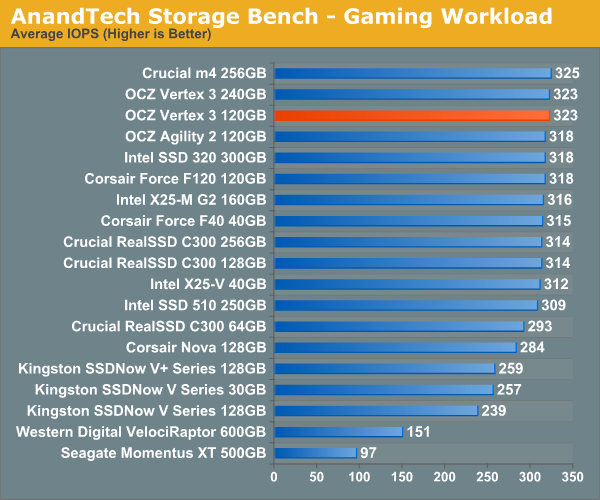The OCZ Vertex 3 Review (120GB)
by Anand Lal Shimpi on April 6, 2011 6:32 PM ESTAnandTech Storage Bench 2010
To keep things consistent we've also included our older Storage Bench. Note that the old storage test system doesn't have a SATA 6Gbps controller, so we only have one result for the 6Gbps drives.
The first in our benchmark suite is a light/typical usage case. The Windows 7 system is loaded with Firefox, Office 2007 and Adobe Reader among other applications. With Firefox we browse web pages like Facebook, AnandTech, Digg and other sites. Outlook is also running and we use it to check emails, create and send a message with a PDF attachment. Adobe Reader is used to view some PDFs. Excel 2007 is used to create a spreadsheet, graphs and save the document. The same goes for Word 2007. We open and step through a presentation in PowerPoint 2007 received as an email attachment before saving it to the desktop. Finally we watch a bit of a Firefly episode in Windows Media Player 11.
There’s some level of multitasking going on here but it’s not unreasonable by any means. Generally the application tasks proceed linearly, with the exception of things like web browsing which may happen in between one of the other tasks.
The recording is played back on all of our drives here today. Remember that we’re isolating disk performance, all we’re doing is playing back every single disk access that happened in that ~5 minute period of usage. The light workload is composed of 37,501 reads and 20,268 writes. Over 30% of the IOs are 4KB, 11% are 16KB, 22% are 32KB and approximately 13% are 64KB in size. Less than 30% of the operations are absolutely sequential in nature. Average queue depth is 6.09 IOs.
The performance results are reported in average I/O Operations per Second (IOPS):

If there’s a light usage case there’s bound to be a heavy one. In this test we have Microsoft Security Essentials running in the background with real time virus scanning enabled. We also perform a quick scan in the middle of the test. Firefox, Outlook, Excel, Word and Powerpoint are all used the same as they were in the light test. We add Photoshop CS4 to the mix, opening a bunch of 12MP images, editing them, then saving them as highly compressed JPGs for web publishing. Windows 7’s picture viewer is used to view a bunch of pictures on the hard drive. We use 7-zip to create and extract .7z archives. Downloading is also prominently featured in our heavy test; we download large files from the Internet during portions of the benchmark, as well as use uTorrent to grab a couple of torrents. Some of the applications in use are installed during the benchmark, Windows updates are also installed. Towards the end of the test we launch World of Warcraft, play for a few minutes, then delete the folder. This test also takes into account all of the disk accesses that happen while the OS is booting.
The benchmark is 22 minutes long and it consists of 128,895 read operations and 72,411 write operations. Roughly 44% of all IOs were sequential. Approximately 30% of all accesses were 4KB in size, 12% were 16KB in size, 14% were 32KB and 20% were 64KB. Average queue depth was 3.59.

The gaming workload is made up of 75,206 read operations and only 4,592 write operations. Only 20% of the accesses are 4KB in size, nearly 40% are 64KB and 20% are 32KB. A whopping 69% of the IOs are sequential, meaning this is predominantly a sequential read benchmark. The average queue depth is 7.76 IOs.











153 Comments
View All Comments
martixy - Monday, April 11, 2011 - link
So... the SSD market is shaping up to the just about the most confusing and volatile market out there.At least that's the impression I get from the articles here. I mean you'd probably need your very own market research team if you want to get a good deal on an SSD.
Meh...
gixxer - Monday, April 11, 2011 - link
So if you have read all the comments up to this point with the OCZ verus Intel debate.Where would you spend your money?
A vertex 3, Intel 320, or Intel 510
MamiyaOtaru - Tuesday, April 12, 2011 - link
it's not scientific, but after looking at the newegg user review averages, not touching anything other than inteltech6 - Monday, April 11, 2011 - link
Thank you Anand - you're a real asset to the tech community!While OCZ has a potentially great product, they are really proving to be their own worst enemy. Until they demonstrate some maturity I will choose an Intel 320 instead. It may not be the newest or fastest but the G1/G2/G3 series drives have so far proven to be reasonably reliable and perform as advertised.
ClagMaster - Monday, April 11, 2011 - link
Seems to me the Intel 510 offers better mainstream performance than the Vertex 3.And I also think Intel does a better job with balancing firmware with memory technology, and has better configuration control of what memory is used for their SSD's.
I think suffering a 20% risk of getting a Vertex 3 SSD with slower memory is too high for what I pay for such a device
qax - Wednesday, April 13, 2011 - link
This sort of commitment can make me wanna buy OCZ next time, thats for sure.Although they shipped slow drives, they accept the responsability, and thats a big thing in my world.
I´ve totaly stopped buying som vendors that are too cheap, resulting in useless/nonexisting support.
Same reason why i allways buy from a psysical shop and never from internetshops.
I need psysical adress not too far from my own adress, where i can turn in a faulty product.
For me an SSD driver will allways be used for OS, programs and games. For space i would have HDD.
So space on SSD is no concern.
javishd - Wednesday, April 13, 2011 - link
I think I'm not alone here. Waiting to buy after some real comparisons of the $300 120gb range. We look to you for help with the decision! Thanks for your long term commitment to ssd. I've been on board since the x25 g1, and I really appreciate all the info from you guys. I'll keep checking every day hoping....alexb1 - Wednesday, April 13, 2011 - link
Anand, THANK YOU VERY VERY MUCH!Honestly, there is NO ONE ELSE in the IT industry advocating for enthusiast consumers like you... kudos!
I am A VICTIM of OCZ Marketing of Vertex2, and got a 80GB recently that basically does EXTREMELY POOR compared to ALL benchmarks. To top it all off, it is NOT part of the *recall* drives as its size hasn't been affected with the 25nm transition... so I am just about to return and take a 15% restocking fee.
Now, my question is... should I even bother looking for a 34nm drive, or one of the newer 25nm drives would just do ok as boot drive in Win7? My MOST CONCERN is reliability and longevity.
I can either get a F60-A (25nm), F60 (34nm), or OCZ Vertex2 (25nm)... The 25nm being $30-40 CHEAPER!
faster - Thursday, April 14, 2011 - link
Today the Intel 510 250GB drive mentioned in these benchamarks can be had at newegg for $615 (-$40 off promo until 4/19, $575).The Egg also has the Revo Drive X2 240GB at $570 (was $680).
So we as consumers have the new 250 GB 6Gbps SATA3 SSD drives vs. the 240GB PCIE X4 integrated bootable RAID 0 card within $5 of the same price point.
Certainly a bootable add in card is not a straight comparison to a single SSD drive, but at the same price point, in the cutting edge overpriced enthusiast level, it is a sensible comparison.
Anandtech should put the RevoX2 in these benchmark charts to show how they measure up. It would be more interesting than comparing a WD Raptor represented by tiny slivers on the performance comparisons. I believe, generally speaking, that the Revo would come away with faster read speeds and be neck in neck with fastest SSD drives on write speeds. AnandTech had or has a RevoDrive that they reviewed in the past. Is that thing still laying around?
daidaloss - Thursday, April 14, 2011 - link
@fasterI second your petition to Anand to put the Revo2 on the charts, so us, real power user, would have an idea how do SSDs compare with PCI raid cards.
Also, sure would be interesting to see how do SSD compare to ram drives like the HyperDrive5. Supposedly this thing boots up in 4 seconds. Should be interesting to compare such a system with a modern SSD.